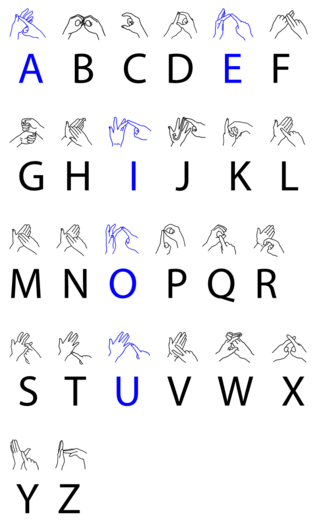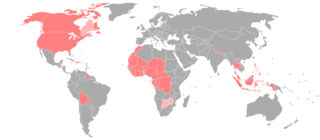Related Research Articles

American Sign Language (ASL) is a natural language that serves as the predominant sign language of Deaf communities in the United States of America and most of Anglophone Canada. ASL is a complete and organized visual language that is expressed by employing both manual and nonmanual features. Besides North America, dialects of ASL and ASL-based creoles are used in many countries around the world, including much of West Africa and parts of Southeast Asia. ASL is also widely learned as a second language, serving as a lingua franca. ASL is most closely related to French Sign Language (LSF). It has been proposed that ASL is a creole language of LSF, although ASL shows features atypical of creole languages, such as agglutinative morphology.

Sign languages are languages that use the visual-manual modality to convey meaning, instead of spoken words. Sign languages are expressed through manual articulation in combination with non-manual markers. Sign languages are full-fledged natural languages with their own grammar and lexicon. Sign languages are not universal and are usually not mutually intelligible, although there are also similarities among different sign languages.
International Sign (IS) is a pidgin sign language which is used in a variety of different contexts, particularly at international meetings such as the World Federation of the Deaf (WFD) congress, in some European Union settings, and at some UN conferences, at events such as the Deaflympics, the Miss & Mister Deaf World, and Eurovision, and informally when travelling and socialising.

British Sign Language (BSL) is a sign language used in the United Kingdom (UK), and is the first or preferred language among the Deaf community in the UK. Based on the percentage of people who reported 'using British Sign Language at home' on the 2011 Scottish Census, the British Deaf Association estimates there are 151,000 BSL users in the UK, of which 87,000 are Deaf. By contrast, in the 2011 England and Wales Census 15,000 people living in England and Wales reported themselves using BSL as their main language. People who are not deaf may also use BSL, as hearing relatives of deaf people, sign language interpreters or as a result of other contact with the British Deaf community. The language makes use of space and involves movement of the hands, body, face, and head.
Martha's Vineyard Sign Language (MVSL) was a village sign-language that was once widely used on the island of Martha's Vineyard from the early 18th century to 1952. It was used by both Deaf and hearing people in the community; consequently, deafness did not become a barrier to participation in public life. Deaf people who signed Martha's Vineyard Sign Language were extremely independent. They participated in society as typical citizens, although there were incidents of discrimination, and language barriers.

Deaf culture is the set of social beliefs, behaviors, art, literary traditions, history, values, and shared institutions of communities that are influenced by deafness and which use sign languages as the main means of communication. When used as a cultural label especially within the culture, the word deaf is often written with a capital D and referred to as "big D Deaf" in speech and sign. When used as a label for the audiological condition, it is written with a lower case d. Carl G. Croneberg coined the term "Deaf Culture" and he was the first to discuss analogies between Deaf and hearing cultures in his appendices C/D of the 1965 Dictionary of American Sign Language.
New Zealand Sign Language or NZSL is the main language of the deaf community in New Zealand. It became an official language of New Zealand in April 2006 under the New Zealand Sign Language Act 2006. The purpose of the act was to create rights and obligations in the use of NZSL throughout the legal system and to ensure that the Deaf community had the same access to government information and services as everybody else. According to the 2013 Census, over 20,000 New Zealanders know NZSL.
Adamorobe Sign Language or Adasl is a village sign language used in Adamorobe, an Akan village in eastern Ghana. It is used by about 30 deaf and 1370 hearing people (2003).
Indo-Pakistani Sign Language (IPSL) is the predominant sign language in the subcontinent of South Asia, used by at least 15 million deaf signers. As with many sign languages, it is difficult to estimate numbers with any certainty, as the Census of India does not list sign languages and most studies have focused on the north and urban areas. As of 2021, it is the most used sign language in the world, and Ethnologue ranks it as the 151st most "spoken" language in the world.
Manually coded languages (MCLs) are a family of gestural communication methods which include gestural spelling as well as constructed languages which directly interpolate the grammar and syntax of oral languages in a gestural-visual form—that is, signed versions of oral languages. Unlike the sign languages that have evolved naturally in deaf communities, these manual codes are the conscious invention of deaf and hearing educators, and as such lack the distinct spatial structures present in native deaf sign languages. MCLs mostly follow the grammar of the oral language—or, more precisely, of the written form of the oral language that they interpolate. They have been mainly used in deaf education in an effort to "represent English on the hands" and by sign language interpreters in K-12 schools, although they have had some influence on deaf sign languages where their implementation was widespread.
Thai Sign Language (TSL), or Modern Standard Thai Sign Language (MSTSL), is the national sign language of Thailand's deaf community and is used in most parts of the country by the 20 percent of the estimated 56,000 pre-linguistically deaf people who go to school. Thai Sign Language was acknowledged as "the national language of deaf people in Thailand" in August 1999, in a resolution signed by the Minister of Education on behalf of the Royal Thai Government. As with many sign languages, the means of transmission to children occurs within families with signing deaf parents and in schools for the deaf. A robust process of language teaching and acculturation among deaf children has been documented and photographed in the Thai residential schools for the deaf.
Iranian Sign Language (ISL) is the sign language used by Deaf and hard-of-hearing people in Iran. It is a true sign language, unlike the Baghcheban phonetic hand alphabet, which is a form of cued speech.
Kata Kolok, also known as Benkala Sign Language and Balinese Sign Language, is a village sign language which is indigenous to two neighbouring villages in northern Bali, Indonesia. The main village, Bengkala, has had high incidences of deafness for over seven generations. Notwithstanding the biological time depth of the recessive mutation that causes deafness, the first substantial cohort of deaf signers did not occur until five generations ago, and this event marks the emergence of Kata Kolok. The sign language has been acquired by at least five generations of deaf, native signers and features in all aspects of village life, including political, professional, educational, and religious settings.
Chinese Sign Language is the official sign language of the People's Republic of China. It is unrelated to Taiwanese Sign Language and is known in the Republic of China as Wénfǎ Shǒuyǔ.
Filipino Sign Language (FSL) or Philippine Sign Language, is a sign language originating in the Philippines. Like other sign languages, FSL is a unique language with its own grammar, syntax and morphology; it is neither based on nor resembles Filipino or English. Some researchers consider the indigenous signs of FSL to be at risk of being lost due to the increasing influence of ASL.
Tibetan Sign Language is the recently established deaf sign language of Tibet.
Deafness has varying definitions in cultural and medical contexts. In medical contexts, the meaning of deafness is hearing loss that precludes a person from understanding spoken language, an audiological condition. In this context it is written with a lower case d. It later came to be used in a cultural context to refer to those who primarily communicate through sign language regardless of hearing ability, often capitalized as Deaf and referred to as "big D Deaf" in speech and sign. The two definitions overlap but are not identical, as hearing loss includes cases that are not severe enough to impact spoken language comprehension, while cultural Deafness includes hearing people who use sign language, such as children of deaf adults.

American Sign Language (ASL) developed in the United States and Canada, but has spread around the world. Local varieties have developed in many countries, but there is little research on which should be considered dialects of ASL and which have diverged to the point of being distinct languages.
References
- ↑ Erik Anonby, Mortaza Taheri-Ardali & Amos Hayes (2019) The Atlas of the Languages of Iran (ALI). Iranian Studies 52. A Working Classification